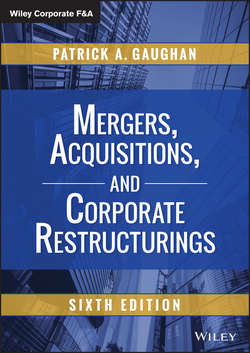Читать книгу Mergers, Acquisitions, and Corporate Restructurings - Gaughan Patrick А. - Страница 26
На сайте Литреса книга снята с продажи.
Part I
Background
Chapter 2
History of Mergers
Second Wave, 1916–1929
ОглавлениеGeorge Stigler, the late Nobel prize–winning economist and former professor at the University of Chicago, contrasted the first and second merger waves as “merging for monopoly” versus “merging for oligopoly.” During the second merger wave, several industries were consolidated. Rather than monopolies, the result was often an oligopolistic industry structure. The consolidation pattern established in the first merger period continued into the second period. During this second period, the U.S. economy continued to evolve and develop, primarily because of the post–World War I economic boom, which provided much investment capital for eagerly waiting securities markets. The availability of capital, which was fueled by favorable economic conditions and lax margin requirements, set the stage for the stock market crash of 1929.
The antitrust environment of the 1920s was stricter than the environment that had prevailed before the first merger wave. By 1910, Congress had become concerned about the abuses of the market and the power wielded by monopolies. It also had become clear that the Sherman Act was not an effective deterrent to monopoly. As a result, Congress passed the Clayton Act in 1914, a law that reinforced the antimonopoly provisions of the Sherman Act. (For a discussion of the Sherman and Clayton Acts, see Chapter 3.) As the economy and the banking system rebounded in the late 1900s, this antitrust law became a somewhat more important deterrent to monopoly. With a more stringent antitrust environment, the second merger wave produced fewer monopolies but more oligopolies and many vertical mergers. In addition, many companies in unrelated industries merged. This was the first large-scale formation of conglomerates. However, although these business combinations involved firms that did not directly produce the same products, they often had similar product lines.
Armed with the Clayton and Sherman Acts, the U.S. government was in a better position to engage in more effective antitrust enforcement than had occurred during the first merger wave. Nonetheless, its primary focus remained on cracking down on unfair business practices and preventing cartels or pools, as opposed to stopping anticompetitive mergers. At this time widespread price-fixing occurred in many industries, which was thought to be a more pressing threat to competition than mergers, which now were mainly vertical or conglomerate transactions. Just as in the first merger wave, the second merger period witnessed the formation of many prominent corporations that still operate today. These include General Motors, IBM, John Deere, and Union Carbide.
